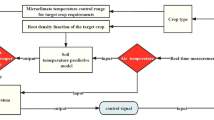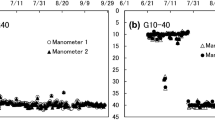Abstract
In this study, we tried to model the processes of moisture and heat transfers in the soil–vegetation–atmosphere system in an integrated comprehensive way. The purpose of the study is to simulate profiles of soil water content and temperature at root active zone (i.e., 0–50 cm), taking the root water uptake, soil evaporation, and canopy transpiration into account. The water and heat transfer equations are solved by an iterative Newton–Raphson technique and a finite difference method is used to solve the governing equations. Soil water content and soil temperature dynamics could be simulated rather accurately in a cropped field on Loess Plateau area. The water and heat transfer flux predicted by the classical theory of Philip and de Vries (Tans Am Geophys Union 38:222–232, 1957) slightly overestimated near the surface and underestimated at the deeper depths, as a result of the overestimated soil evaporation at the top soil layer (0–10 cm) and underestimated crop canopy transpiration at the deeper depths (10–50 cm). Water content tended to be underestimated for the entire profile at the soil surface (from 0 to 50 cm). Soil temperatures during the simulated period was slightly overestimated in the nighttimes and underestimated in the daytimes, as a result of the underestimated soil water content at the top soil layer (0–10 cm) and overestimated at the deeper depths (10–50 cm). Soil temperatures tended to be underestimated for the entire profile at the soil surface (from 0 to 50 cm). While the sum of the water and heat regimes yielded a much better match with the soil water content and soil temperature obtained from the field observations. The results obtained show that the model coupled water and heat transfer is able to capture the dynamics of soil water content.


Similar content being viewed by others
References
Brooks RH, Corey AT (1964) Hydraulic properties of porous media, Hydrology paper, 3, Colorado State University, Fort Collins
Childs SW (1977) Model of soil salinity effects on crop growth. Soil Sci Soc Am J 39:617–622
De Vries DA (1958) Simultaneous transfer of heat and moisture in porous media. Trans Am Geophys Union 39(5):909–919
De Vries DA (1975) Heat transfer in soils. In: De Vries DA, Afgan NH (eds) Heat and mass transfer in the biosphere. Wiley, New York, pp 5–28
Flerchinger GN, Sauer TJ, Aiken RA (2003) Effects of crop residue cover and architecture on heat and water transfer at the soil surface. Geoderma 116:217–233
Milly PCD (1982) Moisture and heat transport in hysteretic inhomogeneous porous media: a matric head-based formulation and a numerical model. Water Resour Resour 18:489–498
Milly PCD, Eagleson PS (1980) The coupled transport of water and heat in a vertical soil column under atmospheric excitation, Technical report 258, R.M. Parsons Lab., Department of Civil Engineers, Massachsetts. Institute of Technolology, Cambridge
Mualem Y (1976) A new model for predicting the hydraulic conductivity of unsaturated porous media. Water Resour Res 12:513–512
Nash JE, Sutcliffe JV (1970) River flow forecasting through conceptual models: Part I. A discussion of principles. J Hydrol 10(3):282–290
Perrochet P (1987) Water uptake by plant roots—a simulation model, I. Conceptual model. J Hydrol 95:55–61
Philip JR, De vries DA (1957) Moisture movement in porous materials under temperature gradients. Tans Am Geophys Union 38:222–232
Van de Griend AA, O’Neill PE (1986) Discrimination of soil hydraulic properties by combined thermal infrared and microwave remote sensing, Proceedings of IGARAA’86 Symposium, Zürich, 8–11 September 1986, Ref ESA SP-254, Published by ESA Publications Division
Van Genuchten MT (1980) A closed-form equation for predicting the hydraulic conductivity of unsaturated soils. Soil Sci Soc Am J 44(5):892–898
Van Genuchten MT (1987) A numerical model for water and solute movement in and below the root zone. Research Report, US Salinity Laboratory, Riverside, CA
Wu HI, Michael Childress W, Li Y, Spence RD, Ren JZ (1996) An integrated simulation model for a semi-arid agroecosystem in the Loess Plateau of Northwestern China. Agri Syst 52:83–111
Wu CL, Huang JS, Shen RK (2000) A model of heat and water flow in SPAC under transparent polyethylene mulch. J Hydraul Eng 31(11):89–96
Xu D, Cai LG (1997) Simulation of infiltration and recharge based on field water balance in cropped soil. J Hydraul Eng 28(12):64–78
Acknowledgments
This work has been financially supported partly by the National Natural Science Foundation of China (No. 20066688) and partly by the Knowledge Innovation Program of Chinese Academy of Science (No. 20066666). The authors are grateful to Pingliang Thunder Lightning Experimental Station, Cold and Arid Regions Environmental and Engineering Research Institute, Chinese Academy of Sciences.
Author information
Authors and Affiliations
Corresponding author
Rights and permissions
About this article
Cite this article
Ao, Y.H., Wen, J. & Lü, S.H. A study of the water and energy transfer at the soil surface in cropped field on the Loess Plateau of northwestern China. Environ Geol 52, 595–603 (2007). https://doi.org/10.1007/s00254-006-0490-z
Received:
Accepted:
Published:
Issue Date:
DOI: https://doi.org/10.1007/s00254-006-0490-z




